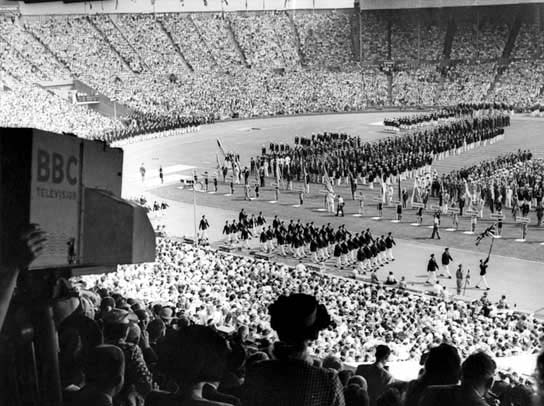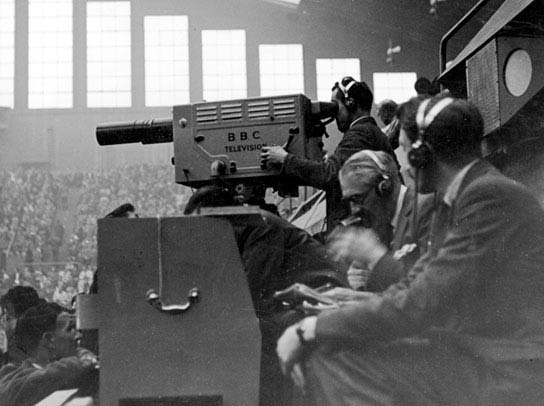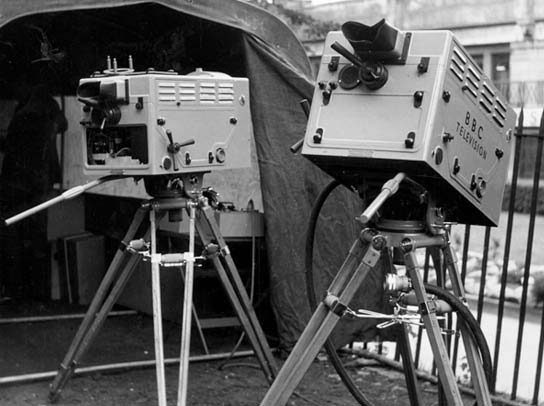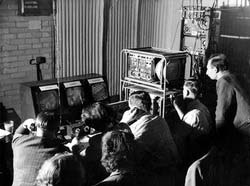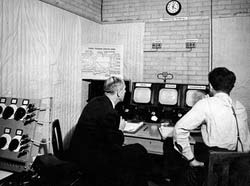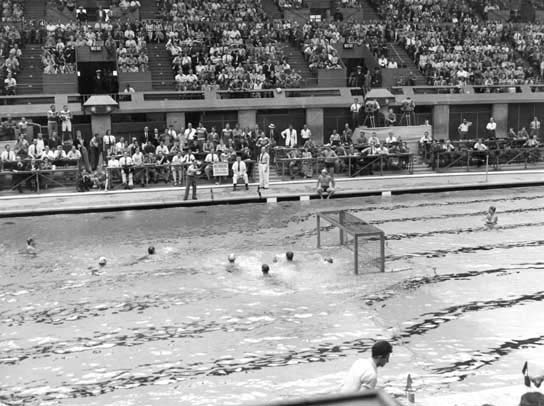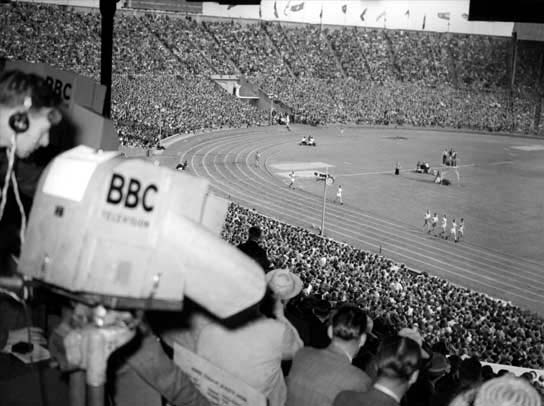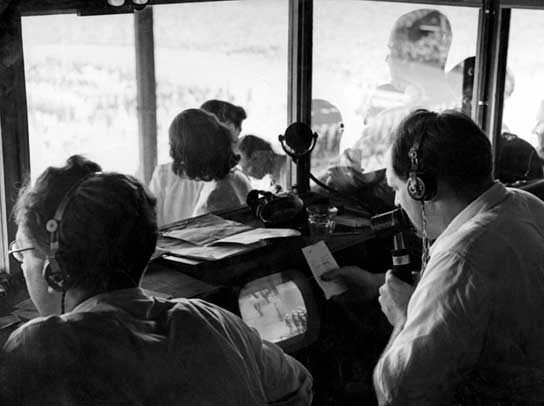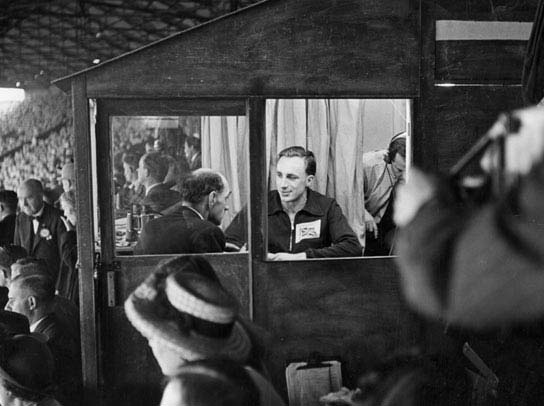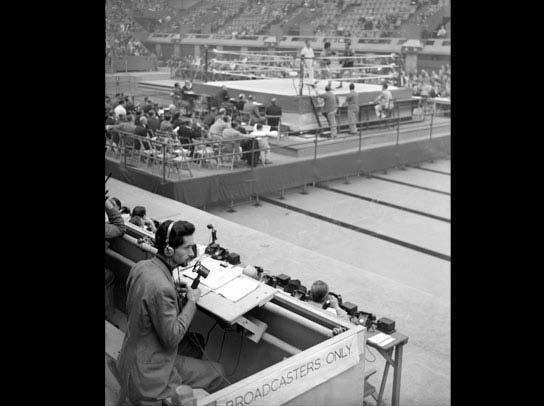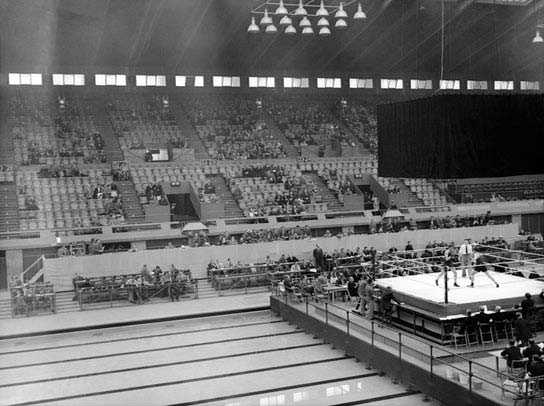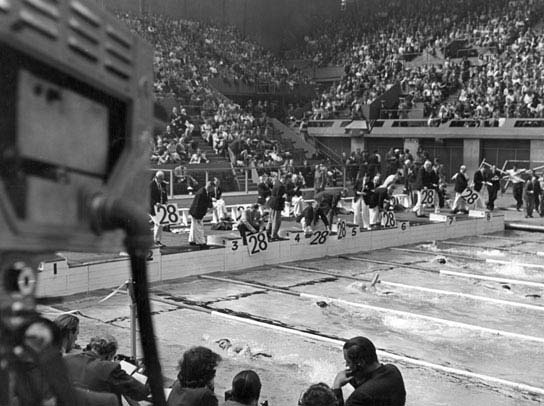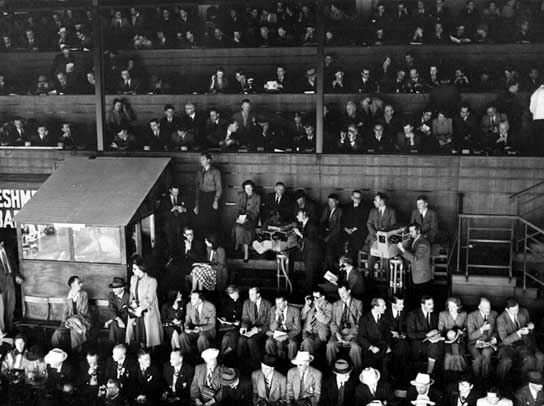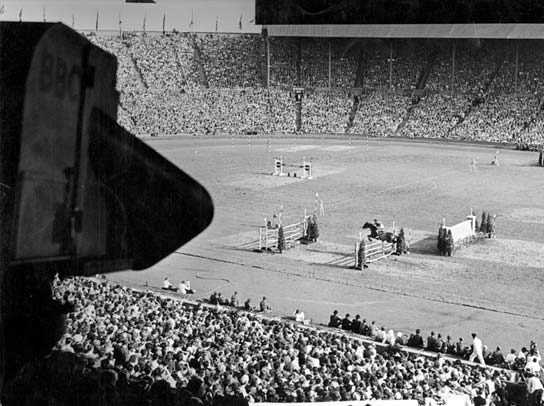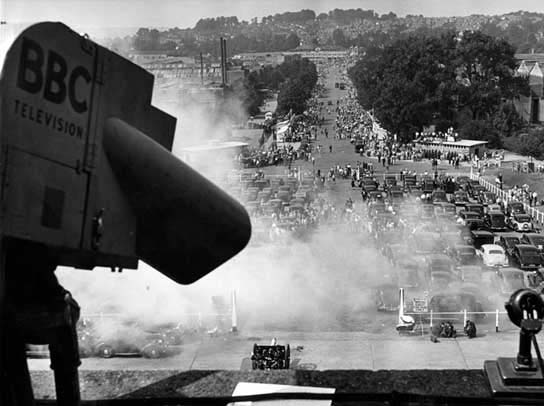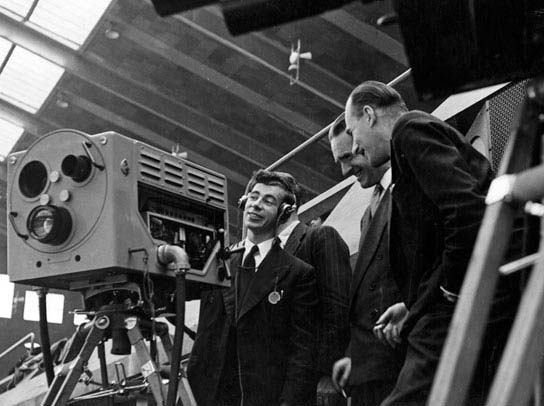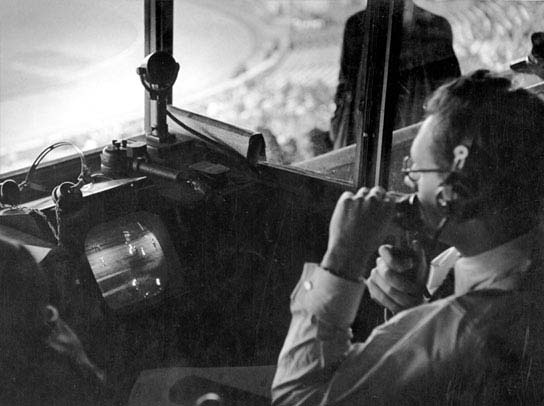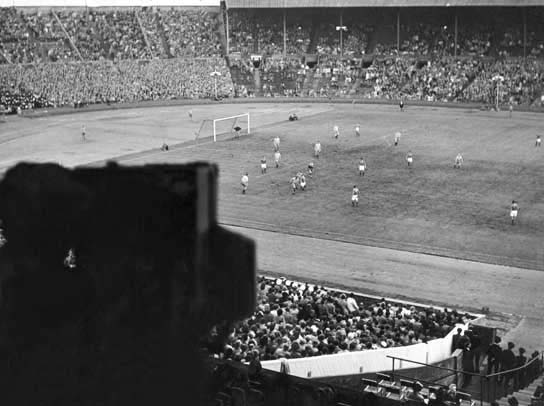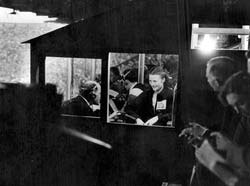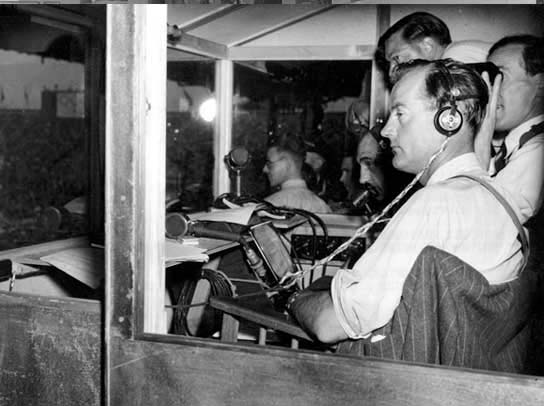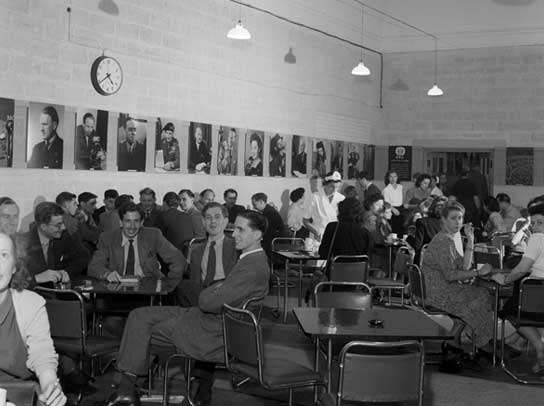Just three years after the end of the Second World War, with both food and fuel still being rationed, London hosted the XIV Olympic Games. They were dubbed ‘The Austerity Games’ with no money for new buildings, existing facilities had to be used. Despite these restrictions fifty-seven countries competed but perhaps understandably, Germany and Japan were not invited. It was a huge undertaking for the BBC. Not only did the BBC produce comprehensive radio broadcasts in this country but also had to provide many commentary positions, studios and other facilities for the foreign radio broadcasters.
In 1948 the BBC’s Television Service was still in its infancy with just one transmitter at Alexandra Palace serving some 80,000 television sets in the London area. The fledgling television service, although restrained by a lack of funds, planned the maximum coverage it could with its meagre resources. At that time the BBC had two television outside broadcast units comprising of a mobile control room, or scanner as they were called then, a transmitter van and a mobile generator truck. The Marconi-EMI Company delivered these units to the BBC in 1937 and 1938. Each control room could accommodate up to three cameras. The outside broadcast department had six Emitron cameras; three of them were the newer more sensitive Super Emitrons, which had to be shared between the two units. According to Peter Dimmock, at the time a television producer, and later Head of BBC TV Outside Broadcasts, the television service was very much the poor relation and looked down on by Broadcasting House. “Oh those peep show boys at Alexandra Palace. They had no idea what was going to happen and thought they (Radio) were top dog and therefore our budgets were restricted.” The Games were to take place over a two week period at venues stretching across London and beyond, with the yachting (sailing) taking place off Torquay. In 1947 it was decided to concentrate the live television coverage to the two main venues, Wembley Stadium and the Wembley Empire Pool. Conveniently the television outside broadcast department had recently moved into the Palace of Industry building on the Wembley site.
In June 1947 Tony Bridgewater, chief engineer for television outside broadcasts, outlined the technical requirements for covering the Games. The main request was that the production control should take place in a central area rather than the mobile control rooms. The main reason for this was that production control in the two-pre war MCRs was rather primitive. Everybody had to stand and there were only two monitors, one for TX and one preview. Standing for the long periods of transmission during the Games would be highly undesirable. It was therefore requested there should be two production rooms, one for each OB unit. The production rooms would have three monitors, a TX, preview and Radio (Off Air from the Alexandra Palace transmitter). Vision mixing would remain in the mobile control rooms but instructions would be given from the production room. It was proposed that the sound mixer in the MCR would not be used with all the mic channels being fed to a portable 8-channel mixer in the relevant production control room. The Central Control Room would contain the necessary monitors to show the programme originating from both units and equipment to switch both vision and audio from either unit to the line to Alexandra Palace. There would also be the facility to take in a possible third programme which, assuming the extra equipment was made available, might be originated elsewhere and received at Wembley by means of a mobile radio receiver.
When the engineers looked at the feasibility of televising inside the Empire Pool where the events would go on well into the evening, it was realised that they would either have to boost the light level using arc lamps or order more sensitive cameras. As the area of the pool was so large it was decided to order a new outside broadcast unit. Peter Dimmock and some of the engineers wanted to buy the new image-orthicon tube cameras from RCA in the US but the BBC was not allowed to import equipment. So a unit was ordered from EMI with three newly developed CPS Emitron tube cameras. According to Peter Dimmock the CPS had an occasional fault. “Suddenly in the right hand corner a white sheet poured across the screen and the picture was gone.” This instability known as “peeling” was a problem for the early tubes. It was caused by a bright object in the field of view, a lamp, or bright specula reflection overloads the tube. Photographers flash bulbs were known to be a serious problem. Once a tube started to peel little could be done until normal operation could be recovered. Despite this fault, the CPS Emitron was a much more reliable camera than it’s predecessors. The standard Emitron tube with it’s spherical glass enclosing the large target meant that the lens was a long way in front of the target and this placed constraints on the usable focal lengths and the depth of field in particular. The Super Emitron had an Image Section in front of the target and this meant that the image from the lens was formed on this smaller photo target which was much nearer the lens thus removing many of the constraints suffered by the Emitron lenses. Additionally it was some 10 times more sensitive enabling the use of telephoto lenses in poor light conditions.Both the Emitron and the Super Emitron suffered from shading (an effect similar to lens vignette or portholing, but much more pronounced and unpredictable) and spurious signals. Correction waveforms had to be added to the picture signal to attempt to alleviate the shading. These waveforms were called “Tilt and Bend” and required frequent adjustment. Additionally because the electron gun that produced the beam that scanned the target was to the side, a distortion know as “keystone distortion” also had to be corrected.The CPS Emitron tube was of the Orthicon class and the target was at the front of the tube, optically good for the lenses and it was scanned orthogonally from the rear so there was no keystone distortion. It was also said that the CPS Emitron tube was free of the shading problems of the Emitron tubes.
In 1948 the BBC’s Television Service was still in its infancy with just one transmitter at Alexandra Palace serving some 80,000 television sets in the London area. The fledgling television service, although restrained by a lack of funds, planned the maximum coverage it could with its meagre resources. At that time the BBC had two television outside broadcast units comprising of a mobile control room, or scanner as they were called then, a transmitter van and a mobile generator truck. The Marconi-EMI Company delivered these units to the BBC in 1937 and 1938. Each control room could accommodate up to three cameras. The outside broadcast department had six Emitron cameras; three of them were the newer more sensitive Super Emitrons, which had to be shared between the two units. According to Peter Dimmock, at the time a television producer, and later Head of BBC TV Outside Broadcasts, the television service was very much the poor relation and looked down on by Broadcasting House. “Oh those peep show boys at Alexandra Palace. They had no idea what was going to happen and thought they (Radio) were top dog and therefore our budgets were restricted.” The Games were to take place over a two week period at venues stretching across London and beyond, with the yachting (sailing) taking place off Torquay. In 1947 it was decided to concentrate the live television coverage to the two main venues, Wembley Stadium and the Wembley Empire Pool. Conveniently the television outside broadcast department had recently moved into the Palace of Industry building on the Wembley site.
MCR 4 was delivered by EMI (Marconi and EMI set up separate television companies after the War) with three CPS Emitrons in time for the Games. MCR 4 was a much more sophisticated unit than the first two mobile control units. It had a monitor for each of its three cameras and the producer, along with the engineers, could sit in relative comfort. The equipment was housed in an articulated trailer with the production console across the width of the vehicle. This was to be the standard design for BBC mobile control rooms until 1954. EMI, Pye and Marconi delivered ten units of this design to the BBC during that period. The CPS Emitron cameras that covered the swimming and boxing had electronic viewfinders. Camera operators had asked for the viewfinder scans to be reversed as they were used to an optical viewfinder that produced a reversed upside down picture. Their request was denied but the operators quickly adapted to new way of working. The CPS cameras also had a turret, which could take up to three lenses of different focal lengths.
Both the Central Control Room and Production Control Rooms were built inside The Palace of Arts, which also accommodated the massive BBC radio facilities. The Palace of Arts was near to the Empire Pool and not too far from the Stadium. Originally it was built for the British Empire Exhibition in 1925. After the Games it became the base for BBC Television Outside Broadcasts until the move to Kendal Avenue.
The events taking place in the Stadium were controlled by the producer and senior engineer from the Production Control Room in the Palace of Arts while at the Pool, because of the relative comfort of the new unit, both engineering and programme control were undertaken in the MCR parked outside the Pool. It was reported that a better standard of production was achieved using the Production Control Room rather than the Mobile Control Room where there was more ‘noise and distraction’. The decision as to whether to take the programme from the Stadium or the Pool was made in the Central Control Room where the output from both events could be viewed on monitors adapted from domestic receivers. The vision and sound from the Control Room was sent to Alexandra Palace for transmission by cables specially installed by the GPO. A television transmitter van and aerial van were parked alongside the Palace of Arts as standby should the cable fail.
On Thursday 29th July 1948 everything was in place to televise the Opening Ceremony. Ian Orr-Ewing, Manager of BBC Television Outside Broadcasts, wrote in his post Games report.
‘ There was a Super Emitron with a 3” lens immediately outside the Stadium looking down Olympic way for the wide opening shots showing the crowds approaching the stadium. The 3” lens was subsequently changed to a 6” to capture shots of the Royal Party coming up the Olympic Way. Unfortunately because the Way was blocked with cars, the Royal Party came along the ordinary approach road and was not well seen. The camera was also there to capture the runner with the Olympic Torch who was supposed to run up to the stadium at 4.07pm but actually came at 3.30pm. ‘Another Super Emitron was positioned in the left hand side of the main camera position just above the royal box. Fitted with a 6” lens, it provided admirable mid-shots. A third camera with a 3” lens, just below the royal box was used for general views and the King’s speech. Richard Dimbleby gave an excellent commentary once he had settled down, but he started inadvertently using sound broadcasting technique and the first ten minutes was shaky.’
When the engineers looked at the feasibility of televising inside the Empire Pool where the events would go on well into the evening, it was realised that they would either have to boost the light level using arc lamps or order more sensitive cameras. As the area of the pool was so large it was decided to order a new outside broadcast unit. Peter Dimmock and some of the engineers wanted to buy the new image-orthicon tube cameras from RCA in the US but the BBC was not allowed to import equipment. So a unit was ordered from EMI with three newly developed CPS Emitron tube cameras. According to Peter Dimmock the CPS had an occasional fault. “Suddenly in the right hand corner a white sheet poured across the screen and the picture was gone.” This instability known as “peeling” was a problem for the early tubes. It was caused by a bright object in the field of view, a lamp, or bright specula reflection overloads the tube. Photographers flash bulbs were known to be a serious problem. Once a tube started to peel little could be done until normal operation could be recovered. Despite this fault, the CPS Emitron was a much more reliable camera than it’s predecessors. The standard Emitron tube with it’s spherical glass enclosing the large target meant that the lens was a long way in front of the target and this placed constraints on the usable focal lengths and the depth of field in particular. The Super Emitron had an Image Section in front of the target and this meant that the image from the lens was formed on this smaller photo target which was much nearer the lens thus removing many of the constraints suffered by the Emitron lenses. Additionally it was some 10 times more sensitive enabling the use of telephoto lenses in poor light conditions.Both the Emitron and the Super Emitron suffered from shading (an effect similar to lens vignette or portholing, but much more pronounced and unpredictable) and spurious signals. Correction waveforms had to be added to the picture signal to attempt to alleviate the shading. These waveforms were called “Tilt and Bend” and required frequent adjustment. Additionally because the electron gun that produced the beam that scanned the target was to the side, a distortion know as “keystone distortion” also had to be corrected.The CPS Emitron tube was of the Orthicon class and the target was at the front of the tube, optically good for the lenses and it was scanned orthogonally from the rear so there was no keystone distortion. It was also said that the CPS Emitron tube was free of the shading problems of the Emitron tubes.
In 1948 the BBC’s Television Service was still in its infancy with just one transmitter at Alexandra Palace serving some 80,000 television sets in the London area. The fledgling television service, although restrained by a lack of funds, planned the maximum coverage it could with its meagre resources. At that time the BBC had two television outside broadcast units comprising of a mobile control room, or scanner as they were called then, a transmitter van and a mobile generator truck. The Marconi-EMI Company delivered these units to the BBC in 1937 and 1938. Each control room could accommodate up to three cameras. The outside broadcast department had six Emitron cameras; three of them were the newer more sensitive Super Emitrons, which had to be shared between the two units. According to Peter Dimmock, at the time a television producer, and later Head of BBC TV Outside Broadcasts, the television service was very much the poor relation and looked down on by Broadcasting House. “Oh those peep show boys at Alexandra Palace. They had no idea what was going to happen and thought they (Radio) were top dog and therefore our budgets were restricted.” The Games were to take place over a two week period at venues stretching across London and beyond, with the yachting (sailing) taking place off Torquay. In 1947 it was decided to concentrate the live television coverage to the two main venues, Wembley Stadium and the Wembley Empire Pool. Conveniently the television outside broadcast department had recently moved into the Palace of Industry building on the Wembley site.
There were also teething problems getting sound feeds from their radio colleagues.
‘It had been agreed that we should take our effects from sound broadcasting. I asked for two feeds, one for the band and one for crowd effects, but they only gave us one feed in which the band was completely predominant and one got no noise from the crowd. On all future occasions we must have two or three feeds.’
That evening there were more problems covering the diving at the Empire Pool.
‘It had previously been decided there would be no diving in the evening and the organisers subsequently put on some demonstration diving on the first night. This produced a bad picture as the diver was silhouetted against some windows. It was not possible to pan down with a lens larger than a 6” (equivalent to a 3” on a Super Emitron).’
After these early problems, the television team went on, over the next fifteen days, to successfully cover all the sports held at the two venues; at the Stadium; athletics, hockey and soccer; while at the Pool; swimming, diving and water polo in the first week, with boxing in the second. The athletics were covered with three cameras. Two cameras were positioned immediately behind the royal box which was just after the finishing line. The main camera had a 6” lens to provide mid shots. Next to it, the second camera had a 12” or 20” lens for close-ups. The second camera also covered the interview studio which was housed in a temporary hut alongside the camera positions. When the second camera was being used for interviews it was fitted with a 3” lens. As the runners got to their marks, they were held in close-up. As the pistol went, the vision mixer automatically cut to a mid-shot. The camera in front of the royal box was fitted with a 4” or 6” lens and provided mid shots closer to the action and captured the runners as they crossed the finishing line. All three cameras were close to each other as it was felt that if the action was seen from a different angle when the camera cut, the viewer would be confused. Ian Orr-Ewing gave this explanation.
‘ These camera positions proved far superior to those selected by the Olympic Film Company, as there was no possible danger of losing geography. Even if we could go into the centre of the arena (presumably the race track) I am certain that there is everything to be gained by being outside the arena where possible ‘
Towards the end of the second week of the Olympics, the Television Service mounted its most ambitious output. Not only was it to broadcast the Olympics, but also the Great Britain v USA Athletics at White City on Thursday, followed by the Test Match from the Oval on Saturday, the last day of the Olympics. That Thursday was the first time that three mobile units had been in use on the same day.
‘An all time record of continuous television was achieved as the service opened at 2.35pm and continued without intermission until 10.35pm The days programmes came from four locations, instantaneous switching being undertaking so that viewers saw the most interesting events in the White City athletics and the Olympic boxing from the Empire Pool, whilst the whole of the hockey final (Great Britain v India- GB lost) from the Stadium was also televised. In addition an Olympic edition Newsreel and a full-length play were broadcast from Alexandra Palace.’
The unit covering the White City athletics on the Thursday and the cricket from the Oval was the second pre-war Marconi-EMI unit. For the athletics, MCR 2 had two Standard Emitrons and one of the Super Emitrons taken from the Stadium. The cricket required two Super Emitrons leaving just one at the Stadium for Friday and Saturday. Most of the soccer final on the Friday between Sweden and Yugoslavia (Sweden Won) and the Closing Ceremony were nearly all televised using the one Super Emitron, as the light was not good enough for the Standard Emitrons to operate.
At the Empire Pool, with the ease to change lenses quickly by means of the turret, it was thought adequate to use just two cameras to cover the swimming events, with the third CPS Emitron camera dedicated to the interview studio. It was found that the best pictures of the action in the pool were from quite a high position. In Ian Orr-Ewing’s report he states.
‘After the first two days both CPS Emitrons in the Pool were moved to camera rostrum furthest from the diving boards. This camera position was too low to be ideal, and this lowness was further aggravated by the fact that the “taking” lens was at the bottom of the camera. However, the cameras could not be raised further without interfering with the line of sight from the spectators to the near edge of the bath. For the water polo one of the cameras was put on the corner at one end of the pool. This position cut down the ‘rate of panning’ needed to keep up with action. ‘
In the second week of the Games, the Empire Pool was used as the venue for the boxing. The main camera position for the boxing was immediately opposite the neutral corner of the ring. Ian Orr-Ewing wrote.
‘Even when there was sufficient light for a 17” lens, the CPS Emitron only provided a close mid-shot. The second camera was put alongside the commentators at the side of the ring. The rope interfered seriously with this lower camera position and was not able to see the boxers’ footwork. During daylight the picture quality was adequate. In the evening “trailing” was so bad that one could only go to close mid shot when the boxers were stationary and one had to use a long mid-shot to take the boxing.’
From BBC Television’s point of view, the Games were a great success. Over the fifteen days, the BBC broadcast over sixty hours of television from Wembley with an estimated half a million viewers. From the Opening Ceremony through the entire Games, the BBC’s cameras captured dramatic action live. The moment when Greta Andersen, suffering from cramp, had to be rescued from the pool and when Gailly (Belgium), after leading for nearly all the twenty six miles in the Marathon, staggered into the Stadium completely exhausted to be passed in the last 300 yards by the winner Cabrora (Argentina) and Richards (Great Britain).
It would be another five years until the Coronation of Queen Elizabeth before viewing figures overtook radio, but the 1948 Olympic Games gave a great boost to the BBC’s Television Service and the sale of television receivers. It would be another twelve years before the next summer Olympic Games would be seen on British television. The 1952 Helsinki Games were not televised and the 1956 Melbourne Games were only seen in Australia. Viewers had to wait until the Rome Olympics in 1960.
